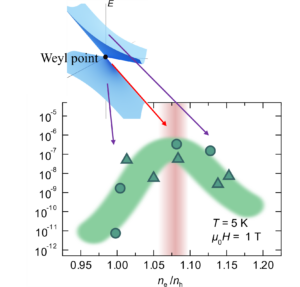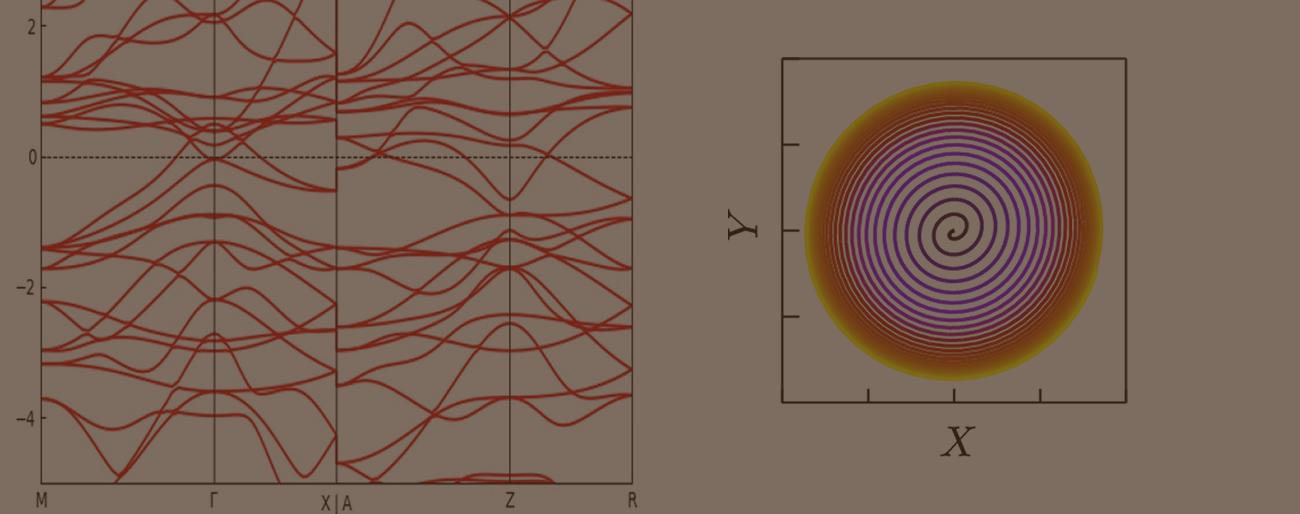
RESEARCH
OUR RESEARCH
“NEXT-GENERATION” SOLID STATE PHYSICS
【Click here for the 2025 Lab Brochure (in Japanese) (PDF will open)】
Please see also the video below for information on FY2025 (in Japanese).。
Shiomi Lab Online Guidance Video (April 2025)
Experimental Studies in Condensed Matter Physics and Spintronics
Recent keywords: magnetism, spin current, topology, magneto-piezoelectric effect, multipoles, quantum liquid crystal (nematic order), phase change material, hydrogen, superconductor
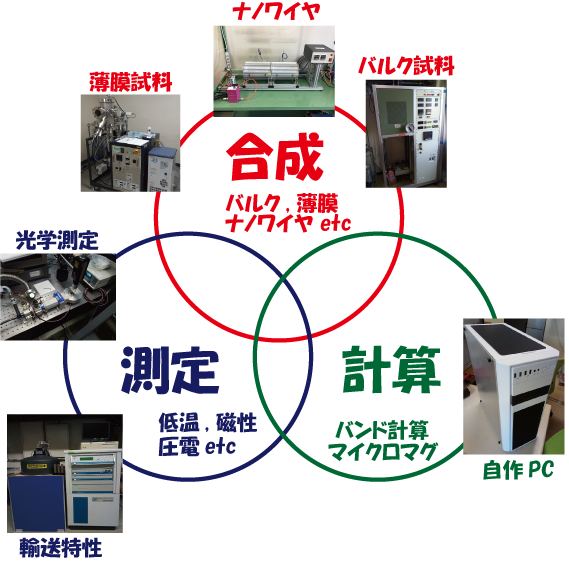
Shiomi Lab is engaged in the development of quantum materials and measurement of their physical properties, especially focusing on magnetic materials (so-called magnets). Our goal is to obtain research results that will lead to new technologies in next-generation spintronics. Our laboratory is particularly unique in the research at the interface between spintronics and neighboring fields. Recently, for example, we have achieved the fusion of phase-change recording technology and spintronics, as well as the modulation of spin properties using clean energy, hydrogen.
Students can choose to work mainly on sample synthesis or on physical property measurements, depending on their interests. We also use computers to perform band calculations and micromagnetic simulations and analyze experimental results (just to be clear, this does not mean that everyone has to do the calculations). If even one of the above pictures interests you, please contact Shiomi.
In terms of sample synthesis, we are engaged in bulk material synthesis (floating-zone method, Bridgeman method, etc.), thin film synthesis (sputtering method, etc.), and nanowire synthesis (CVD method, etc.). We are also interested in multilayer samples of different materials such as magnetic and superconducting thin films, and the modification of organic molecules on metal surfaces. We have photolithography equipment for shared use, and are also working on microscale device fabrication using 2D materials.
Our physical property measurements include spin current phenomena at room temperature (using electromagnets, etc.), thermoelectric and magnetotransport phenomena under high magnetic fields at low temperatures (superconducting magnets, etc.), piezoelectric effects at low temperatures (laser Doppler vibrometer, etc.), and optical measurements (electromagnets + windowed cryostat). We are also working on the search for novel physical properties related to the latest keywords in condensed matter physics, such as topology, quantum liquid crystals, and spin currents. Our department also has a magnetic property measurement system (MPMS) for detailed measurement of spin properties. We also conduct experiments at large-scale experimental facilities at other institutions, such as High Magnetic Field Center at IMR of Tohoku University, KEK, and JAEA.
For analysis of experimental results, we also perform band calculations and micromagnetic simulations using a computer (self-built) and a supercomputer (used on campus). We would like to actively work on the use of machine learning.
As for laboratory activities, in addition to monthly research progress meetings, we regularly hold textbook reading sessions and Journal Clubs (paper introductions). Students are responsible for arranging the textbook reading session/Journal Club, and other lab events (such as cleanup, year-end party, etc.).
To give you an idea of the research activities of Shiomi Lab, some examples of research themes are presented below.
Synthesis and properties of nanowire materials
While we have been preparing various material samples ranging from bulk materials to thin-film materials, nanowires have recently been the focus of our attention. While methods have been established for the synthesis of bulk materials (3D structures) and thin-film materials (2D structures) for a variety of material systems, the synthesis of nanowire samples with 1D structures is limited to some semiconductor samples. Since dimensionality is very important in physics, new physical properties and functions can be developed if nanowire samples of various material systems can be obtained. We are challenging to fabricate nanowires of various materials, especially topological materials, and to apply them to spintronics.
【Reference】”Quantum oscillations from Fermi arc surface states in Cd3As2 submicron wires” Phys. Rev. Research 4, L022002 (2022)
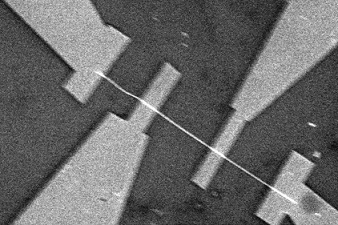
Development of magnetic thermoelectric materials and spin caloritronics function
The thermoelectric effect is a phenomenon of conversion between electrical energy and thermal energy, and is attracting industrial attention because it can generate electrical energy from waste heat. From the standpoint of basic research, we are developing new thermoelectric materials containing magnetic elements and controlling the thermoelectric effect by controlling magnetism. We are also conducting spin-current transport measurements such as spin Seebeck effect in order to develop spin caloritronics (a new fusion research area of heat and spintronics) functions in exotic materials.
【Reference】”Anisotropic Magneto-Seebeck Effect in Antiferromagnetic Semimetal FeGe2” Phys. Rev. B 104, 115109 (2021)
【Reference】”Reconfigurable single-material Peltier device consisting of magnetic-phase junctions” Sci. Rep. 11, 24216 (2021)
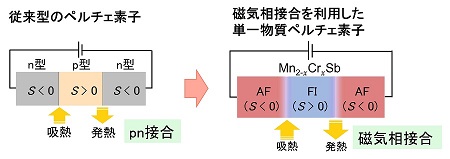
Hydrogen sensing using spin currents
Hydrogen is attracting attention as a clean energy source for a decarbonized society. We are studying modulation of spin current properties by hydrogenation with the aim of contributing to hydrogen technology in spintronics. We have shown that hydrogenation reduces the spin Seebeck effect and the spin Hall magnetoresistance by half their magnitude in a junction structure of Pd, a typical hydrogen storage alloy, and YIG, a magnetic insulator. In addition to elucidating the physical causes of the reduction of the spin current signal, we aim to realize new spintronic devices using reversible hydrogen modulation.
【Reference】”Modulation of Spin Seebeck Effect by Hydrogenation”Appl. Phys. Lett. 120, 072405 (2022)
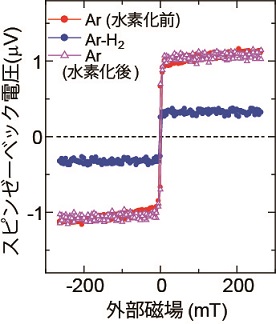
Phase-change material science
Phase-change materials are used as phase-change memory, utilizing the changes in reflectance and electrical resistivity that occur when a material undergoes a phase change between crystalline and amorphous states as 0 and 1 states. We are exploring new physical properties and material functions by physically reviewing phase-change materials. For example, phase change in physics is not limited to crystal-amorphous phase change, but is a very broad concept that includes magnetic phase transition. By expanding the concept of phase-change materials, new material functions may be obtained. In addition, physical property changes other than reflectance and electrical resistivity (such as magnetic transport phenomena) accompany the phase change, so we are investigating the various physical property changes associated with the phase change in materials.
【Reference】”Phase-Change Control of Anomalous Hall Effect in Ferromagnetic MnBi Thin Films” Appl. Phys. Lett. 121, 262402 (2022)
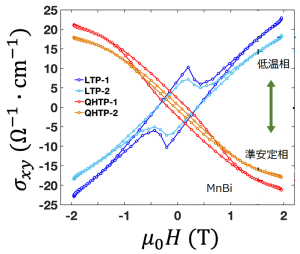
“Mott-like” transition by amorphization
By utilizing large experimental facilities, we are also developing new material functions that cannot be realized in the laboratory. By irradiating single crystal samples with high energy heavy ion beams using the tandem accelerator at JAEA, one can create an amorphous state with a strongly disordered structure. We have shown that amorphization of a two-dimensional ferromagnetic semiconductor CrGeTe3 by Xe ion irradiation induces an insulator-to-metal transition. The amorphous metallic state has a magnetic transition temperature about three times higher than that of CrGeTe3 crystal. This amorphization may be regarded as a “Mott-like” transition, since similar ferromagnetic metallic states with a high magnetic-transition temperature were reported in the previous studies of Mott transition in CrGeTe3 single crystals. We are not only pursuing the physics behind the nontrivial amorphous ferromagnetic metallic state in CrGeTe3 by using local structure measurements at KEK, but also developing novel physical properties such as amorphous superconductivity through material expansion.
【Reference】”Amorphous Ferromagnetic Metal in van der Waals Materials” Adv. Electron. Mater. 10, 2300609 (2023)
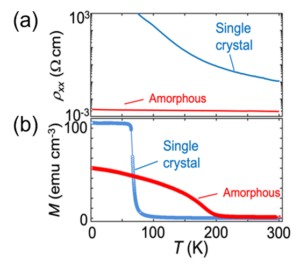
Magneto-optical imaging of current-induced magnetization such as spin Hall effect
In the field of spintronics, interconversion phenomena between electric current and spin (current) have been widely studied. Typical examples are the spin Hall effect and the Edelstein effect. On the other hand, physical phenomen induced by symmetry breaking have been widely studied in condensed matter physics, and the phenomenon in which electric current induces magnetization due to symmetry breaking is called current-induced magnetization. We have developed a non-contact and highly sensitive magneto-optical imaging system for spin accumulation measurement in order to understand the current-spin interconversion phenomena, which shoule be a useful probe not only in spintronics but also in a wide range of fields of condensed matter physics.
【Reference】”Enhancement of Current-Induced Out-of-Plane Spin Polarization by Heavy-Metal-Impurity Doping in Fe Thin Films” Phys. Rev. Applied 16, 054001 (2021)
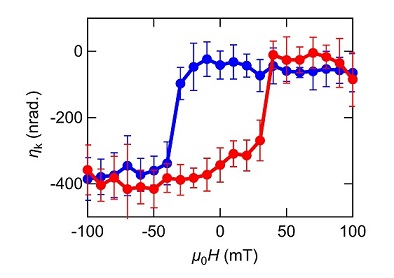
Piezoelectric effect in conducting materials
The piezoelectric effect enables the conversion of electrical energy and mechanical energy and is used in sensors and actuators. Since the piezoelectric effect is significantly weakened by conduction electrons, it has been thought to occur only in insulating materials. We aim to explore new piezoelectric effects in conducting materials by adding new degrees of freedom such as superionic conduction and magnetism. If we can obtain composite functional materials that combine piezoelectric properties, magnetism, and conductivity, we can incorporate them into electronic circuits and open up new (spin) electronic functions.
【References】”Giant Piezoelectric Response in Superionic Polar Semiconductor”Adv. Electron. Mater. 1800174 (2018)
【References】”Observation of a Magnetopiezoelectric Effect in the Antiferromagnetic Metal EuMnBi2“Phys. Rev. Lett. 122, 127207 (2019)
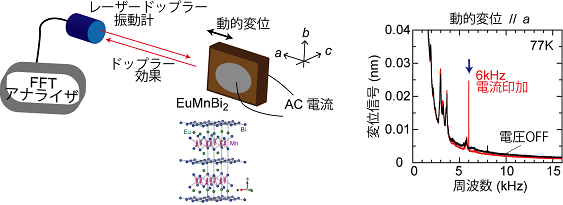
Topological Spintronics
In the field of spintronics which utilizes the spin degree of freedom in addition to the charge degree of freedom of electrons, our research especially focuses on spin currents. In particular, we are exploring novel spin-current functions based on the topological concepts, which are expected to have advantageous properties for power saving in devices. We aim to develop next-generation spintronics devices utilizing topological materials such as topological insulators and realize giant spin-charge conversion related to the Berry phase.
【References】“Spin-electricity conversion induced by spin injection into topological insulators”Phys. Rev. Lett. 113, 196601 (2014)
【References】”Efficient Edelstein effects in one-atom-layer Tl-Pb compound” Appl. Phys. Lett. 113, 052401 (2018)

Nonreciprocal transport in qunatum materials and superconductors
Non-reciprocal transport effect, in which the electrical resistance differs for currents in opposite directions in a single material, could be used as a rectifier device or an AC-DC converter. We have observed a giant nonreciprocal response in a topological material: the Weyl semimetal WTe2. When the Fermi level coincides with the Weyl point, topological effects are maximized and the magnitude of the nonreciprocal response also takes a maximum value. We are also studying other material systems such as nonreciprocal response originating from the superconducting vortex in superconductors, and novel nonreciprocal response of the thermoelectric (Seebeck) effect.
【References】”Giant Magnetochiral Anisotropy in Weyl-semimetal WTe2 Induced by Diverging Berry Curvature” Phys. Rev. Lett. 130, 136301 (2023) (Editors’ suggestion)
